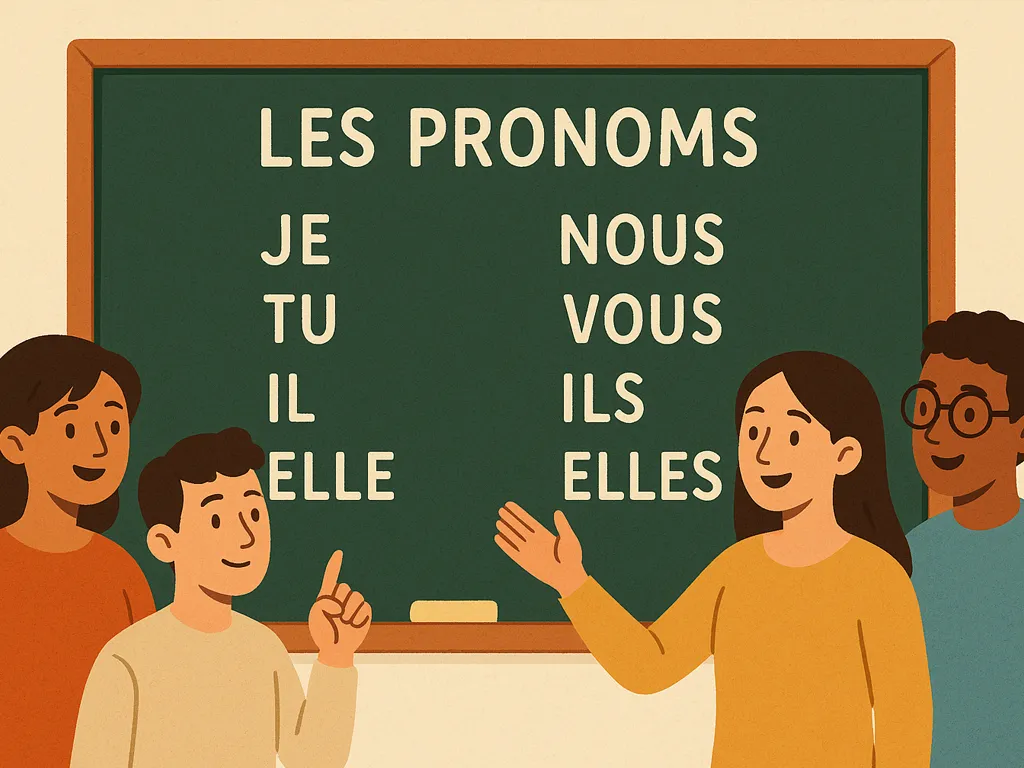
Complete Guide to French Pronouns: Types, Usage & Examples
📚 The Complete Guide to French Pronouns
💡 What Are French Pronouns?
Pronouns are words that replace nouns in a sentence. In French, pronouns are essential for fluent communication and come in various forms. Each type serves a specific purpose and follows particular placement rules in sentences.
The French pronoun system is more complex than English, but learning it systematically will help you master this crucial aspect of French grammar. Let’s explore each type of French pronoun:
🇫🇷 Shortcuts: French Pronouns at a Glance
- 📌 Subject pronouns: je, tu, il/elle, nous, vous, ils/elles
- 📌 Direct object pronouns: me, te, le/la, nous, vous, les
- 📌 Indirect object pronouns: me, te, lui, nous, vous, leur
- 📌 Position rule: Object pronouns go BEFORE the verb in French
- 📌 Agreement rule: Many pronouns must match the gender and number of the noun they replace
🇫🇷 Subject Pronouns (Pronoms Sujets)
Subject pronouns replace the subject (person or thing performing the action) in a sentence:
Subject Pronouns in French
- je – I
- tu – you (informal, singular)
- il – he/it (masculine)
- elle – she/it (feminine)
- on – one/we/people (indefinite)
- nous – we
- vous – you (formal singular or plural)
- ils – they (masculine or mixed group)
- elles – they (feminine only)
Example: Marie est française. → Elle est française. (Marie is French. → She is French.)
🇫🇷 Object Pronouns in French
Direct Object Pronouns (Pronoms Compléments d’Objet Direct)
Direct object pronouns replace the direct object (person or thing directly affected by the verb) in a sentence. In French, they are placed before the conjugated verb:
Direct Object Pronouns
- me/m’ – me
- te/t’ – you (informal)
- le/l’ – him/it (masculine)
- la/l’ – her/it (feminine)
- nous – us
- vous – you (formal/plural)
- les – them
Example: Je mange la pomme. → Je la mange. (I eat the apple. → I eat it.)
Indirect Object Pronouns (Pronoms Compléments d’Objet Indirect)
Indirect object pronouns replace the indirect object (typically preceded by “to” or “for” in English) in a sentence. They also appear before the verb:
Indirect Object Pronouns
- me/m’ – to/for me
- te/t’ – to/for you (informal)
- lui – to/for him/her
- nous – to/for us
- vous – to/for you (formal/plural)
- leur – to/for them
Example: Je parle à mon ami. → Je lui parle. (I talk to my friend. → I talk to him.)
🇫🇷 Other Important French Pronouns
Reflexive Pronouns (Pronoms Réfléchis)
Reflexive pronouns are used with reflexive verbs when the subject performs an action on itself:
Reflexive Pronouns
- me/m’ – myself
- te/t’ – yourself (informal)
- se/s’ – himself/herself/itself/oneself
- nous – ourselves
- vous – yourself/yourselves (formal/plural)
- se/s’ – themselves
Example: Je me lave. (I wash myself.)
Disjunctive/Stressed Pronouns (Pronoms Toniques)
Disjunctive pronouns are used for emphasis, after prepositions, and in many other contexts:
Disjunctive Pronouns
- moi – me
- toi – you (informal)
- lui – him
- elle – her
- soi – oneself
- nous – us
- vous – you (formal/plural)
- eux – them (masculine)
- elles – them (feminine)
Examples:
C’est pour moi. (It’s for me.)
Lui et moi, nous allons au cinéma. (He and I are going to the cinema.)
Possessive Pronouns (Pronoms Possessifs)
Possessive pronouns replace a noun and indicate possession. They must agree in gender and number with the noun they replace:
Possessive Pronouns
| Owner | Masculine Singular | Feminine Singular | Plural Masculine | Plural Feminine |
|---|---|---|---|---|
| My | le mien | la mienne | les miens | les miennes |
| Your (informal) | le tien | la tienne | les tiens | les tiennes |
| His/Her/Its | le sien | la sienne | les siens | les siennes |
| Our | le nôtre | la nôtre | les nôtres | les nôtres |
| Your (formal/plural) | le vôtre | la vôtre | les vôtres | les vôtres |
| Their | le leur | la leur | les leurs | les leurs |
Example: Ma voiture est rouge et la sienne est bleue. (My car is red and his/hers is blue.)
Demonstrative Pronouns (Pronoms Démonstratifs)
Demonstrative pronouns replace and point out specific nouns:
Demonstrative Pronouns
- celui – this one/that one (masculine singular)
- celle – this one/that one (feminine singular)
- ceux – these ones/those ones (masculine plural)
- celles – these ones/those ones (feminine plural)
These can be combined with -ci (this) and -là (that):
- celui-ci – this one here (masculine)
- celle-là – that one there (feminine)
Example: Je préfère celui-ci à celui-là. (I prefer this one to that one.)
Relative Pronouns (Pronoms Relatifs)
Relative pronouns connect clauses and replace nouns that have already been mentioned:
Relative Pronouns
- qui – who/which/that (subject)
- que – whom/which/that (direct object)
- dont – whose/of which/of whom
- où – where/when
- lequel/laquelle/lesquels/lesquelles – which (after prepositions)
Examples:
La femme qui parle est ma mère. (The woman who is speaking is my mother.)
Le livre que je lis est intéressant. (The book that I’m reading is interesting.)
⚠️ Common Mistakes and Tips
⚠️ Common Mistakes with French Pronouns
- Placing direct and indirect object pronouns after the verb (they go before in French)
- Confusing direct and indirect object pronouns
- Forgetting to make possessive pronouns agree with the noun they replace
- Using the wrong gender for pronouns (especially important with “le” and “la”)
💡 Tips for Mastering French Pronouns
- Practice each type of pronoun separately before combining them
- Pay attention to pronoun placement in sentences
- Learn the gender of nouns to correctly replace them with pronouns
- Listen to native speakers and notice how they use pronouns
- Create flashcards with example sentences for each pronoun type
🗣️ Perfect Your French Pronoun Usage
Need help mastering French pronouns? Our experienced tutors can guide you through this essential aspect of French grammar with personalized exercises and explanations.
Book a session with our native tutors when you contact us today and take your French skills to the next level!
Interactive French
French language educator and content creator at Interactive French.
Related Posts

Why Learn French in Hong Kong: Career, Immigration & Exam Benefits
💼 Career Advantages 🎓 Academic Pathways 💯 Official French Exams 🌍 Cultural Benefits 🇭🇰 Your…
Read More
5 Essential Tips to Sound Like a Native French Speaker
Silent Letters French ‘R’ Sounds Avoid English Influence Immersion Tips Colloquial Expressions 1. Don’t Pronounce…
Read More
Self-Learning French: Effective Tips & Resources Guide
Introduction Setting Goals Building Foundation Immersive Learning Practice Speaking 🇫🇷 Introduction Learning a new language…
Read More